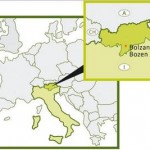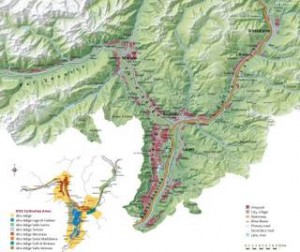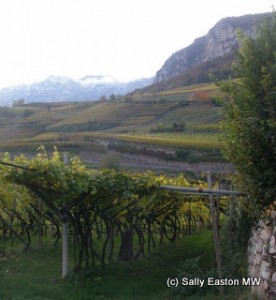Altitude-acclaimed wines from pre-Alpine Alto Adige

Alto Adige
Nestled into the early foothills of the Alps, lies Italy’s most northerly wine region, with the Dolomites as dramatic backdrop. The region is culturally (and historically) more Germanic than Italian, and signage is bi-lingual, which seems to satisfy the three official languages of this autonomous region, though Südtirol makes for a less alliterative headline. Its architecture, topography, cuisine and punctual habit lay claim to a leading Teutonic disposition.
The region’s wines also reflect the cooler, northern, more aromatic paradigm, being some 1,000 miles distant from Italy’s toes tripping through the warmly lush Mediterranean Sea.
Micro-scale
Reflective of the cooler location, and necessary site-selection that it requires, volumes of wine are not large, indeed microscopy is the order of the game in Alto Adige/Südtirol. The region produces just 0.7% of Italy’s total wine output, less than 3.5 million cases in total (smaller volumes than several single wine brands such as Australia’s Yellow Tail or Jacob’s Creek). Yet there are no fewer than eight DOCs, named for the various hills and valleys in the Y-shaped incision that is the pre-Alpine Alto Adige, which follows the Isarco river as it flows into the Adige on its way south, then east to the Adriatic.

The Y of Alto Adige
These eight DOCs cover just 5,100 hectares (ha). This makes the average vineyard holding just 0.65 ha, so no-one is making much of anything. Added into the micro-scale are the more than 20 different grape varieties grown in the region. Small wonder the 15 co-operatives are so important here, accounting for 70% of the harvest. What makes this region different is that several of the co-ops are highly regarded for the quality of wine they produce. Outside of the co-ops nearly 150 producers account for the remainder, making and marketing their own wines.
Wines with altitude
Altitude has a significant influence here. Vineyards range from 200m to 1,000 metres above sea level. Only 15% of the region’s land surface area is below 1,000 metres. Above this lie meadows and pastures for livestock before seriously mountainous territory intervenes. Cooling Alpine winds are clearly an influence, as is warming Mediterranean influence. Bozen/Bolzano is often the warmest city in Italy.
Given its Alpine heritage, soil and bedrock composition are massively variable, though the region lays claim to the largest porphyry plate in the Alps. Porphyry is a group of igneous rocks with large grained crystals in a finer-grained mass, and the Alto Adige variety is red.

Vineyard slopes
Interestingly, given the topographical and pedological complexity of the region, several producers cited altitude as a more important influence on a single grape variety than soil/bedrock, as there is a huge difference in average temperatures over the 800m spread of vineyard altitudes. Michael Goëss-Enzenberg, the owner of Tenuta Manincor said: “for a type of grape variety the altitude is more important. I couldn’t plant pinot noir at 200 metres, it would be overripe and jammy.”
Pinot noir needs a cool and cooler climate to perform at its aromatic best, and there is a tiny amount produced in Alto Adige/Süd Tyrol. But it is local red grape varieties schiava and lagrein that account for a third of the vineyard area, and some of these are interesting. Overall, though, white wines edge out the reds, made from aromatic and semi-aromatic varieties, including pinot grigio, pinot bianco (weissburgunder/pinot blanc), sauvignon blanc and Müller Thurgau. Gewürztraminer is something of a speciality in the region.
The best are very good indeed. Here’s a small selection (more to follow) from the short visit I made in November. Fruity purity, focus, definition and flavour concentration are the watchwords.
Cantina Tramin, Pinot Grigio Unterebner 2007, Alto Adige DOC
Coming from a high vineyard 450 to 600 metres altitude.
Lush, slippery glycerol showing off a full body; linear profile, rich white stone fruit, focused.
Cantina Terlano, Weissburgunder classico 2008, Terlano DOC
This had stainless steel fermentation and 5 months on lees.
Creamy, white flowers, white nuts, pure linear profile, medium-full body, has faint salty tang (some might argue this is minerality?) that tingles on the tongue. Long palate and finish. Rich, almost white peachy. Really very nice.
Cantina Terlano, Quarz 2007, Terlano DOC
This has spent a year in 500 litre casks.
100% sauvignon blanc, showing a crystallised pineapple nose, with ginger notes. Full, rich, lush fruit, yet dry. Smooth, glycerol-like feeling with rich, full texture. Focus of fruit, clear definition, and some significant concentration, it demands attention. Long; long.
Tenuta Manincor, Sophie 2008, Vigneti della Dolomiti IGT
A blend of chardonnay, viognier, sauvignon blanc, “like salt and pepper in food” said the owner.
Fresh, with flavours of melon, white peach and stoniness; there’s an attractive chalky character to the mid palate creating a wine of elegance, and with dimension.
Weingut Unterortl, Castel Juval Riesling 2008.
Limey intensity, with a mountain-fresh purity of focus. Medium bodied, with massive concentration, great elegance and a long palate profile. And a very long finish. Outstanding.
Tenute Loacker, Gewurztraminer 2008 Atagis, Alto Adige DOC
Atagis is an old name for river Isarco.
Aromatic rose petal, with a freshness of attack and attractive medium weight; the tasting balance is dry, with concentration and dry lusciousness. There are even some hints of green apple in the wine’s core. The (14%) alcohol is seamlessly integrated, giving a remarkably light yet intense whole.
My research visit to the region in November 2009 was sponsored by the Italian Trade Commission (ICE) and EOS, the export organisation of South Tyrol.



